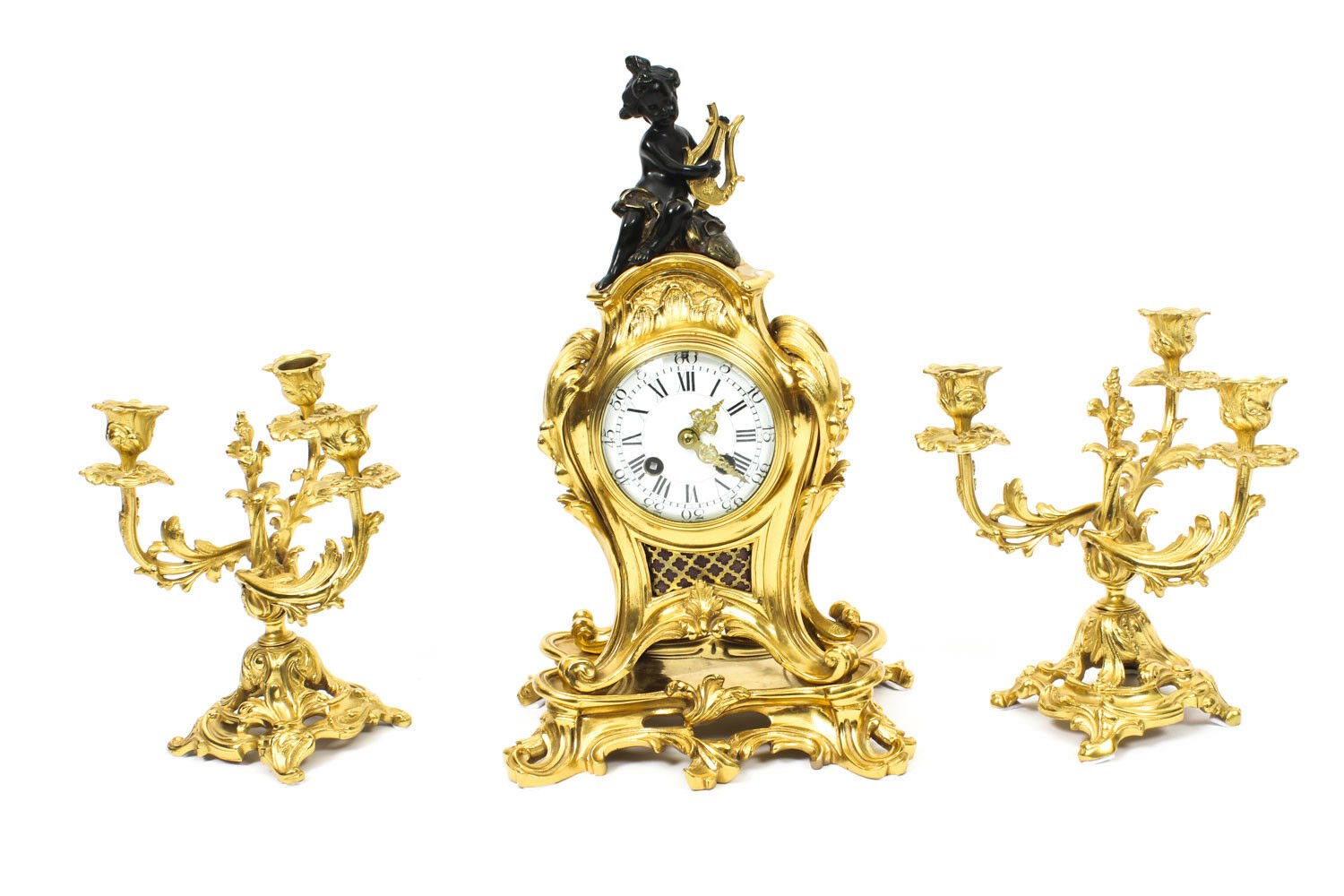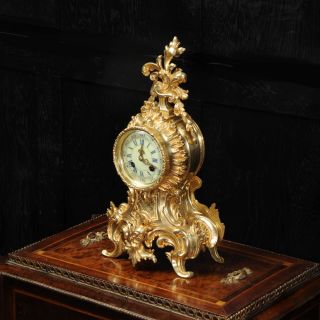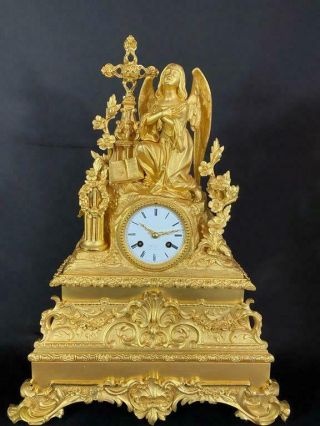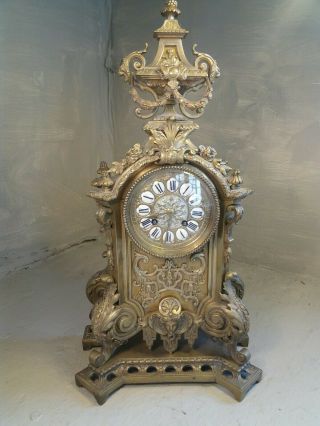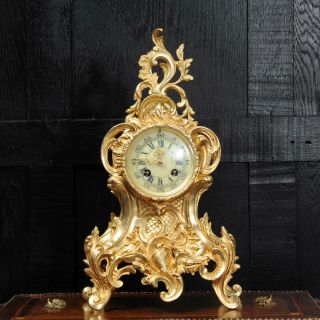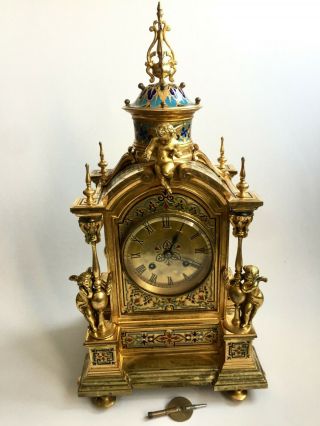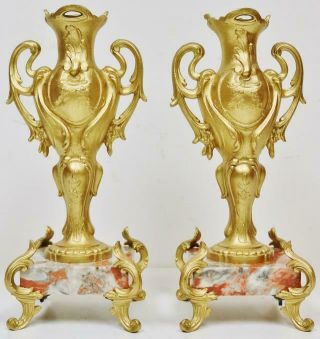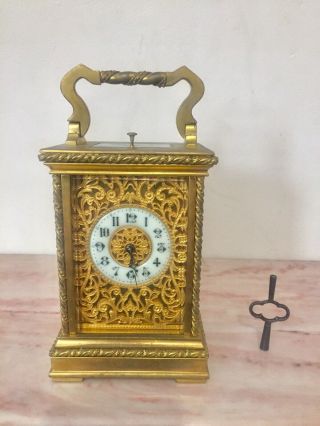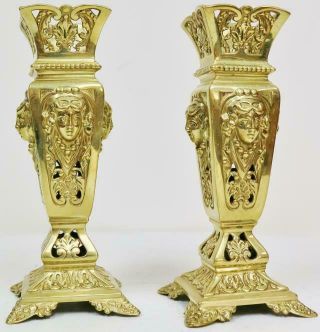Antique French Gilt Bronze Rococo Mantel Clock Garniture Set 19th Century
Item History & Price
| Reference Number: Avaluer:18989956 |
OUR LONDON SHOWROOMS OPEN MON to FRI 10am - 5pm And Alternate Saturdays Regent Antiques has been trading in London for three decades.
We specialise in English and Continental antique furniture, silver and porcelain.
Our main markets are Europe and North America and we export worldwide. Antique French Gilt Bronze Rococo Mantel Clock Garniture Set 19th Century This is a fantastic quality and impressive French gilt bronze Rococo Reviv...al mantel clock garniture, circa 1890 in date.
The elaborately cast rococo case is ornately decorated with swirling acanthus and'C' scrolls. The bronze patinated top is crowned with a cherub playing a Lyre and sitting on a beautiful rococo base.
The white enamelled dial has Roman numerals and Arabic minute marks, the twin train movement with outside countwheel and striking on a bell is in perfect working order. The movement has the serial No. 1645 and the clockmakers mark Japy Freres on the backplate.
The fine pair of matching candelabra echo the swirling acanthus, 'C' scrolls, of the clock and feature three arms twin-scrolled arms and ornate stiff-leaf sconces The French movement is of high quality and is in excellent clean and running condition having been fully overhauled by our clockmaker. It features its original pendulum, runs for 8 days and strikes the hours and half hours
Condition:
The clock is in excellent fully restored working condition, the movement having been expertly serviced and the case polished.
Dimensions in cm:Height 38 x Width 23 x Depth 16 - ClockHeight 22 x Width 20 x Depth 19 - CandelabraDimensions in inches:Height 15.0 x Width 9.1 x Depth 6.3 - ClockHeight 8.7 x Width 7.9 x Depth 7.5 - Candelabra
There are so many JAPY clocks still around because Frédéric Japy (1749-1812) was a pioneer in the industrialization of not only clocks, but of manufacturing in general. An imaginative inventor of all sorts of machines, he began his career as a watchmaker.
The son of Jacques Japy (1699-1781) and Marie Marguerite Fainot (1745-1797), Frédéric Japy was born on May 22, 1749 at Beaucourt , a small village at the end of the principality of Montbéliard . He was the second born of a large family of twelve children. One of the wealthiest families in Beaucourt , the father of Frédéric Japy, Jacques, was a major player in the village and, in 1760, he became the Protestant mayor Beaucourt.
Frédéric Japy began school in Beaucourt. From childhood, he was introduced to craft activities and learned to live in a structured and supportive business environment. His schoolmaster quickly noticed his great intelligence and encouraged his father to send him to Montbéliard to continue his education. Jacques Japy thus placed his son in French school or "gymnasium" where he received an excellent education
Frédéric Japy was apprenticed by Jacques Georges Frédéric Japy, his grandfather, in the profession of watchmaker in Montbeliard. At age 17, he returned to Beaucourt to spend two years working in the workshop of his father.
At that time, watch and clock parts were manufactured usually by hand by specialized workers in their homes in small communities.
The parts were then collected and mounted into a piece by an 'assembler'. Once the movement was assembled, it was then sent to a 'dresser' who would, in turn, mount it into a case - be it a small one or an elaborate brass plated mantle clock complete with mythological figures.
Frederic Japy purchased some of few clocks making machines in existence, brought them back to his native town of Beaucourt and proceeded to invent new ones in order to standardize the pieces and the quality of the production.
The workers were then regrouped into one location instead of being scattered throughout the countryside and each one was assigned to a specific work post with its own specific machine. Frederic Japy radically changed the way clocks were produced. The sequential production of parts in one location - a manufacturing plant - aided by machines meant that clock parts were made and assembled in about half the time that it had taken previously.
Japy's plant revolutionized manufacturing. Production schedules were now established by the plant owner and not by the local artisan. The number of steps and operations were reduced by half. All parts could be assembled into a finished product on-site instead of the previous sub-assemblies and the machines could be operated by a less-skilled worker.
Japy then imagined other applications (and invented the machines required to produce them) such as the mass production of hardware parts (screws, nails, bolts) and other products - rotating pumps (a model still in use today), locks, and he perfected the creation and baking of enamelware.
In clockmaking - Japy's enamel dials became the standard for the great majority of clock manufacturers for 150 years both in France and abroad. There are few French carriage clocks in existence that do not have Japy enamel dials on them.
the 1878 Grand Prize for clockmaking.
Japy's plants continued to produce clocks in many styles and at the higher priced levels. In 1806, he handed the direction of his businesses to his three sons - and it became Japy Frères (Japy Brothers) who, in turn, diversified the manufacturing to produce coffee grinders, typewriters, enamelware, kitchen utensils, office machines such as the first typewriters, refrigerator pumps, advertising signs and they invented more machines to transform copper and steel wires into elaborate hardware parts.
However, his sons' sons did not inherit the creative and inventive spirit of their fathers and grandfather and by the early 1900's, many of the businesses were sold off and the manufacturing was dismantled.
In the 1930's, Japy Frères decided to 'reinvent' themselves to appeal to a wider market and they produced several models with tin casings and in various geometrical styles. Unfortunately, they were competing with names such as Jaz and Blangy in that segment of the market and sales were rather limited. As with most French clockmakers, WWII basically decimated them.
Our reference: R0039 Image gallery Take a tour of our London showrooms Write to us: Regent Antiques Manor Warehouse 318 Green Lanes London N4 1BX By Underground: Take Piccadilly line to Manor House station. Go to top of escalators and turn left. Take exit 7 and walk straight on for 10 metres. Manor Warehouse is on the right. By road: There is car parking available on site. Payment Pay with your credit card through PayPal.
Please make all cheques payable to "Regent Antiques."
Bank details: Regent Antiques - BBVA - Account: 05701615 - Sort: 23-59-11 Shipping and returns We ship worldwide.
Postage and packing for:
Mainland UK: FREE
European Union: £50.00
North America: £75.00 (Please note that this is in Pounds Sterling, not US Dollars)
Rest of world: £95.00
If you require shipping to a location for which a shipping charge is not provided, please ask for a quote prior to bidding.
Williams and Hill Forwarding is our preferred shipping agent for our valuable and fragile furniture items delivered within the UK.
After you purchase, we will make all the arrangements to get your item to your door. Stephen Morris Shipping is our preferred specialist for delivery outside of the UK.
Increased shipping costs incurred when purchasing additional items are generally quite low. For the best value, we recommend offsetting this cost by purchasing multiple items. We require that someone be home on the agreed delivery day if applicable, otherwise a redelivery fee will apply.
In accordance with Distance Selling Regulations, we offer a 30-day money back guarantee if you are not satisfied with the item.
The item must be returned in its original packaging and condition. Unless the item is not as described in a material way, the buyer is responsible for return shipping expenses.
Buyers are fully responsible for any customs duties or local taxes that may be incurred on items sent outside of the European Union.
We specialise in English and Continental antique furniture, silver and porcelain.
Our main markets are Europe and North America and we export worldwide. Antique French Gilt Bronze Rococo Mantel Clock Garniture Set 19th Century This is a fantastic quality and impressive French gilt bronze Rococo Reviv...al mantel clock garniture, circa 1890 in date.
The elaborately cast rococo case is ornately decorated with swirling acanthus and'C' scrolls. The bronze patinated top is crowned with a cherub playing a Lyre and sitting on a beautiful rococo base.
The white enamelled dial has Roman numerals and Arabic minute marks, the twin train movement with outside countwheel and striking on a bell is in perfect working order. The movement has the serial No. 1645 and the clockmakers mark Japy Freres on the backplate.
The fine pair of matching candelabra echo the swirling acanthus, 'C' scrolls, of the clock and feature three arms twin-scrolled arms and ornate stiff-leaf sconces The French movement is of high quality and is in excellent clean and running condition having been fully overhauled by our clockmaker. It features its original pendulum, runs for 8 days and strikes the hours and half hours
Condition:
The clock is in excellent fully restored working condition, the movement having been expertly serviced and the case polished.
Dimensions in cm:Height 38 x Width 23 x Depth 16 - ClockHeight 22 x Width 20 x Depth 19 - CandelabraDimensions in inches:Height 15.0 x Width 9.1 x Depth 6.3 - ClockHeight 8.7 x Width 7.9 x Depth 7.5 - Candelabra
There are so many JAPY clocks still around because Frédéric Japy (1749-1812) was a pioneer in the industrialization of not only clocks, but of manufacturing in general. An imaginative inventor of all sorts of machines, he began his career as a watchmaker.
The son of Jacques Japy (1699-1781) and Marie Marguerite Fainot (1745-1797), Frédéric Japy was born on May 22, 1749 at Beaucourt , a small village at the end of the principality of Montbéliard . He was the second born of a large family of twelve children. One of the wealthiest families in Beaucourt , the father of Frédéric Japy, Jacques, was a major player in the village and, in 1760, he became the Protestant mayor Beaucourt.
Frédéric Japy began school in Beaucourt. From childhood, he was introduced to craft activities and learned to live in a structured and supportive business environment. His schoolmaster quickly noticed his great intelligence and encouraged his father to send him to Montbéliard to continue his education. Jacques Japy thus placed his son in French school or "gymnasium" where he received an excellent education
Frédéric Japy was apprenticed by Jacques Georges Frédéric Japy, his grandfather, in the profession of watchmaker in Montbeliard. At age 17, he returned to Beaucourt to spend two years working in the workshop of his father.
At that time, watch and clock parts were manufactured usually by hand by specialized workers in their homes in small communities.
The parts were then collected and mounted into a piece by an 'assembler'. Once the movement was assembled, it was then sent to a 'dresser' who would, in turn, mount it into a case - be it a small one or an elaborate brass plated mantle clock complete with mythological figures.
Frederic Japy purchased some of few clocks making machines in existence, brought them back to his native town of Beaucourt and proceeded to invent new ones in order to standardize the pieces and the quality of the production.
The workers were then regrouped into one location instead of being scattered throughout the countryside and each one was assigned to a specific work post with its own specific machine. Frederic Japy radically changed the way clocks were produced. The sequential production of parts in one location - a manufacturing plant - aided by machines meant that clock parts were made and assembled in about half the time that it had taken previously.
Japy's plant revolutionized manufacturing. Production schedules were now established by the plant owner and not by the local artisan. The number of steps and operations were reduced by half. All parts could be assembled into a finished product on-site instead of the previous sub-assemblies and the machines could be operated by a less-skilled worker.
Japy then imagined other applications (and invented the machines required to produce them) such as the mass production of hardware parts (screws, nails, bolts) and other products - rotating pumps (a model still in use today), locks, and he perfected the creation and baking of enamelware.
In clockmaking - Japy's enamel dials became the standard for the great majority of clock manufacturers for 150 years both in France and abroad. There are few French carriage clocks in existence that do not have Japy enamel dials on them.
the 1878 Grand Prize for clockmaking.
Japy's plants continued to produce clocks in many styles and at the higher priced levels. In 1806, he handed the direction of his businesses to his three sons - and it became Japy Frères (Japy Brothers) who, in turn, diversified the manufacturing to produce coffee grinders, typewriters, enamelware, kitchen utensils, office machines such as the first typewriters, refrigerator pumps, advertising signs and they invented more machines to transform copper and steel wires into elaborate hardware parts.
However, his sons' sons did not inherit the creative and inventive spirit of their fathers and grandfather and by the early 1900's, many of the businesses were sold off and the manufacturing was dismantled.
In the 1930's, Japy Frères decided to 'reinvent' themselves to appeal to a wider market and they produced several models with tin casings and in various geometrical styles. Unfortunately, they were competing with names such as Jaz and Blangy in that segment of the market and sales were rather limited. As with most French clockmakers, WWII basically decimated them.
Our reference: R0039 Image gallery Take a tour of our London showrooms Write to us: Regent Antiques Manor Warehouse 318 Green Lanes London N4 1BX By Underground: Take Piccadilly line to Manor House station. Go to top of escalators and turn left. Take exit 7 and walk straight on for 10 metres. Manor Warehouse is on the right. By road: There is car parking available on site. Payment Pay with your credit card through PayPal.
Please make all cheques payable to "Regent Antiques."
Bank details: Regent Antiques - BBVA - Account: 05701615 - Sort: 23-59-11 Shipping and returns We ship worldwide.
Postage and packing for:
Mainland UK: FREE
European Union: £50.00
North America: £75.00 (Please note that this is in Pounds Sterling, not US Dollars)
Rest of world: £95.00
If you require shipping to a location for which a shipping charge is not provided, please ask for a quote prior to bidding.
Williams and Hill Forwarding is our preferred shipping agent for our valuable and fragile furniture items delivered within the UK.
After you purchase, we will make all the arrangements to get your item to your door. Stephen Morris Shipping is our preferred specialist for delivery outside of the UK.
Increased shipping costs incurred when purchasing additional items are generally quite low. For the best value, we recommend offsetting this cost by purchasing multiple items. We require that someone be home on the agreed delivery day if applicable, otherwise a redelivery fee will apply.
In accordance with Distance Selling Regulations, we offer a 30-day money back guarantee if you are not satisfied with the item.
The item must be returned in its original packaging and condition. Unless the item is not as described in a material way, the buyer is responsible for return shipping expenses.
Buyers are fully responsible for any customs duties or local taxes that may be incurred on items sent outside of the European Union.



